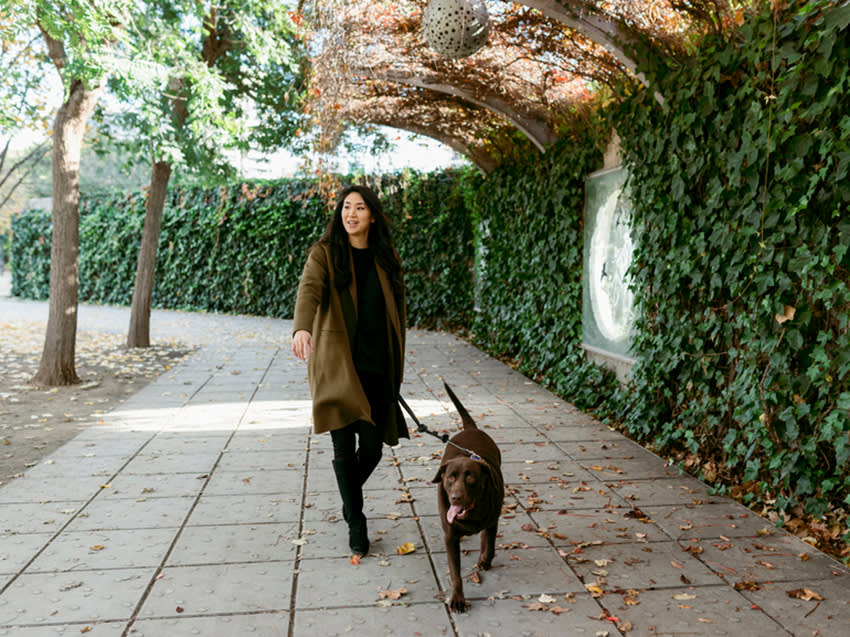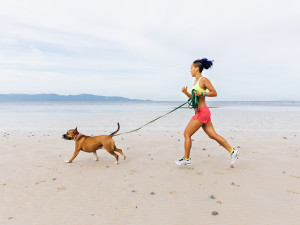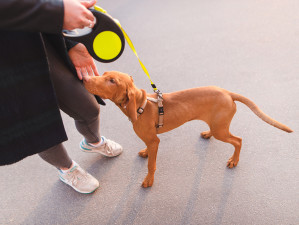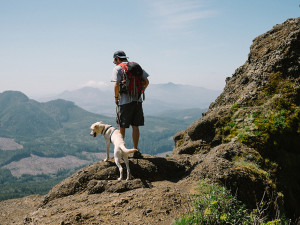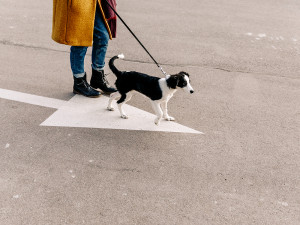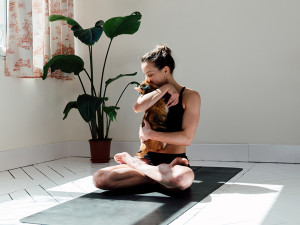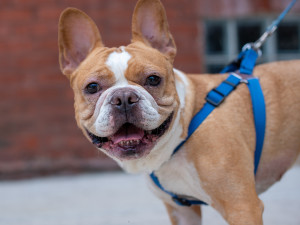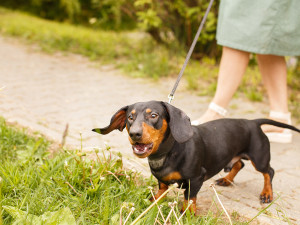Dog Walking 101: How Often Should You Walk Your Dog?
And why you shouldn’t skip the longer routes.
The first week of October means it’s definitely officially fall and not too early to pull out those Halloween decorations. It also means, depending on where you live, that you can start crunching through the fall leaves while taking your pup for a walk. What better week to do that then National Walk Your Dog Week?
Of course, this isn’t the only week you and your pal should pound the pavement of your neighborhood or hit a nearby trail. You’ll want to create a routine that you both can depend on. Consider these factors to establish an ideal walking schedule catered to your dog’s fitness needs.
Step one: Consider your dog’s age, activity level, and breed traits.
Higher-energy breeds, like herding and sporting dog, require 30 to 60 minutes of vigorous exercise daily, including longer jogs or runs. In contrast, lower-energy or senior dogs may only need one or two shorter 15-minute walks.
Step two: Assess their physical condition.
Note your dog’s physical condition and fitness, which are visible in muscle tone, ideal body condition score, endurance, and mobility. Make walking a priority for overweight dogs or those losing strength from arthritis. Remember, active, athletic dogs need more challenging walks to stay fit.
Step three: Gauge their enthusiasm and engagement on walks.
Dogs who pull persistently near the end or fixate on chasing things need a bigger outlet for pent-up energy. If ignored, this can turn into destructive behavior.
Step four: Change it up.
Rotate different locations and routes to provide mental stimulation with the new territory, sights, and smells. Dogs who walk frequently benefit mentally from visiting novel areas.
Step five: Monitor your dog’s energy levels.
Watch for signs your dog tuckers out on walks, like lagging far behind, seeking shade, heavy uncontrolled panting, or refusing to move on. End walks before exhaustion sets in.
Step six: Watch for signs of heat stroke.
Avoid heat stroke by walking early or late in the day when the pavement is cooler. Provide your pup with ample shade and water breaks.
How often should you walk your dog?
First, let’s be clear: There’s a difference between letting your dog out to pee and going for a walk. When it comes to pee breaks, “adult dogs need to be let out for bathroom breaks a minimum of three times a day,” says Dr. Ashley Rossman, a veterinarian at Glen Oak Dog and Cat Hospitalopens in new tab. “Puppies need even more than that, especially when they’re not yet housebroken.” Beyond that, how much time your dog needs to burn off energy will depend on their age and breed.
Consider these factors.
It can feel tricky to figure out exactly how much to walk a dog, because there are no hard-and-fast rules. You’ll have to consider a few different factors, including age and breed. “Younger dogs have more energy than older dogs, obviously, and will need more time to walk or run around,” Dr. Rossman says. “Older dogs, especially ones dealing with issues like arthritis, may need shorter walks to avoid causing additional pain.
Working dogs — think Retrievers and Sheepdogs — need at least 30 minutes of significant exercise.” (Those of you with working-group puppies: hope you’ve got good running shoes.) In general, larger dogs are recommended to get more exercise opens in new tab than smaller dogs.
How often you walk your dog will also depend on whether you have a yard, per Lauren Novack, a certified dog behavior consultant at Behavior Vetsopens in new tab in NYC. If a dog has free run of the yard, they’re not going to need as formal an exercise routine as a pet whose idea of open space is the hallway from the bedroom to the front door. Still, Novack says people tend to under-exercise their dogs — especially small ones.
On top of age and breed, there’s another factor that can affect the length and quality of your dog’s walk: heat. “Walks in the summer are tricky,” Dr. Rossman admits. While you can bundle a dog up in the winter, there’s less you can do to manage the temperature on a warm day. So if it’s hot and sunny (temps above 80 degrees Farhrenheit), don’t keep your dog out for too long.” During the summer, early morning or evening walks are your safest options to keep your pet from burning their paw pads or overheating.
“Heat exhaustion is very real, and the emergency rooms see many cases,” Dr. Rossman adds. Some breeds are more prone to overheating, like Malamutes or Huskies, because they’re bred for colder weather. Older dogs and sick pets can struggle in the heat, too, as can brachycephalic breeds, such as Pugs, Bulldogs, and Boxers.
“Always remember to bring drinking water for your pet,” she says. “And don’t go hiking midday — if you do, make sure you’re seeking out trails that have plenty of shade so your dog has a way to stay cool.” But a hot day isn’t an excuse to veg out: Keep your dog moving indoors with an old-school tug-of-war session or interactive dog puzzle toys.
How long should a dog walk be?
“An hour-long walk every day is generally a good recommendation — preferably all in one session,” Novack says. “A long walk benefits a dog’s physical body as well as their mental health. The problem with a 15-minute walk is that you’re not going anywhere new.” If you can’t time block your calendar for an hour-long walk a day, consider hiring a dog walker to ensure your dog gets the exercise they need — even if you’re working from home.
What are the benefits of dog walking?
Studies findopens in new tab that most dogs aren’t getting the recommended amount of exercise, which is a big problem. Walking a dog is a great source of exercise and can have enormous impacts on a dog’s quality of life — and their pet parent’s. Below are a few of the benefits of walking a dog.
Physical health
Dog-walking is great for the physical health of both you and your pup. Regular walking is associated with a lower risk of cardiovascular disease in humansopens in new tab, and lack of exercise is associated with obesity in dogs, which can lead to a handful of health concerns.
Mental health
Dogs thrive on variety just like we do, so if they’re stuck in the same loop, they’ll eventually find it uninspiring. And dogs who aren’t getting enough exercise become something worse than couch potatoes.
“If you’re not walking your dog enough or providing them with enough playtime, they can become anxious or destructive,” says Dr. Sara Ochoa, a veterinarian at Whitehouse Veterinary Hospitalopens in new tab. “They might tear up the house or start licking their paws obsessively.” That energy has to go somewhere, and sometimes it’s going to go into chewing all the wires behind the TV.
Socialization
Socialization is incredibly important for dogs — especially puppies — and dog walking is a great opportunity to introduce your pup to the dogs and people of the world. For puppies, going for walks can help them learn how to interact with other dogs and people and read dog body language, plus prevent them from developing phobias.
Walking a dog is a great opportunity for humans to socialize, too; many people see a dog as a conversational “icebreaker”opens in new tab when meeting people in public. Given that loneliness has been declared a public health crisis by the US Surgeon General, meeting new human friends at the dog park is a welcome side-effect of some puppy bonding time.
Bonding
Walking with your dog gives the two of you plenty of quality time together, and this helps you strengthen your bond. When the time you spend together is fun, it sends a message to your pup that they can trust you. Animal behaviorist Dr. Karen B. London recommends taking your dog on a “sniffari” to take the fun up a notch.
Physical activity should be fun.
That said, not all dogs like walking. It makes sense — you may prefer a bike over a treadmill, right? Novack suggests finding a form of activity that excites your dog, like playing fetch or swimming. Your dog may even master an agility course. Researching what your dog’s breed traditionally enjoys can help, too.
Or maybe it’s you who doesn’t like walks because your dog pulls on their leash or is aggressive toward other animals. “In that case, try training techniques and walking gear to help your dog heel, or walk them when you’re less likely to see other dogs, like late at night,” Dr. Ochoa says. (Peak dog-walking hours tend to be right after rush hour, when people get home from work.)
FAQs (People also ask):
Is there a recommended daily walk duration for dogs?
According to certified dog trainer Lauren Novack, an hour-long walk every day is generally a good recommendation. Specific needs depend on the breed and age of your dog.
How many days a week should I walk my dog; do dogs need to be walked every day?
Ideally, you should walk your dog every day.
What is the best time to walk your dog?
There’s not one ideal walking schedule for dogs; the best time to walk your dog is whenever fits in best with your and your pup’s day. In hot weather, you may want to walk your dog in the early morning or late evening, when the temperature is lower and the ground is not too hot.
Should I feed my dog before or after a walk?
You can feed a dog before or after exercise, but it’s important to wait about an hour before or after the walkopens in new tab. Feeding too soon before or after physical activity can be bad for your pup’s digestion — and it can even be dangerous, since eating soon after exercise may cause them to inhale more air when eating, which can lead to bloa t.
What is the safest way to walk a dog?
There are several factors to consider to keep your walk safe. It’s important for you, your pup’s, and your community’s safety that your dog is leash trained. Always use proper exercise equipment. Keep your pup hydrated and safe from any harsh weather.
What is the purpose of walking a dog?
Walking a dog is important for your dog’s emotional and physical health. It also promotes bonding and provides an opportunity for you and your dog to socialize.
